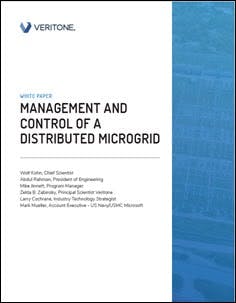Distributed Microgrid Management and Control: Reducing Energy Costs
In its new white paper, Veritone describes the distributed microgrid management and control system that it developed with Microsoft to reduce energy costs.
Using Microsoft’s Azure secure cloud-based architecture and Veritone’s rules-based distributed edge controllers, the two companies have created highly scalable technology that will allow “rapid deployment from initial distributed energy resources initiatives to Smart Cities spanning contents,” according to the report. The cloud-based architecture and the distributed optimization edge control system exchange information in real-time to “transfer commitment and dispatch commands to the distributed edge controllers, and to receive from the edge controllers the updated parameters in a specified framework.”
The white paper details the technology’s hierarchical economic dispatch and unit command. Currently, the economic dispatch runs every five minutes, but the authors expect this will increase to every 30 seconds. The report also explains the system’s operational functionality. The paper goes on to explain how the system provides distributed edge control for microgrids, synchronizes each controlled distributed energy resource (DER), and allows for the synchronization of multiple edge DERs. The authors provide charts that explain the general DER control system, the Cooperative Distributed Inferencing (CDI) agent synchronizer at the edge, and the data tomography used by Veritone. There are additional graphics showing frequency and phase synchronization, the system synchronizer with harmonic reduction, rule-based control with learning, and the CDI inference element network.
“Our goal is to use these proven technologies that provide generation/load balance while satisfying the essential requirements to achieve, maintain and recover generation/load synchronization in distributed microgrids and dramatically improve the efficiency of DER/renewables which significantly reduces energy cost and carbon footprint.” — Veritone, “Management and Control of a Distributed Microgrid“
The authors explain how the system’s DER controller architecture utilizes Azure Internet of Things (IoT). “Azure IoT provides a platform for building secure and scalable, device-centric solutions for connecting devices, conducting analysis and integrating with back-end systems,” according to the report. “This architecture enables the flow of information between intermittent or continuously connected devices and line-of-business assets and cloud-based back-end systems for the purpose of analysis, control and business process integration.”
Ultimately, the paper claims that the “architecture can support millions of connected devices” that are either directly or indirectly connected to the system via a cloud gateway.
Download the full report, “Management and Control of a Distributed Microgrid” from Veritone to further explore how the technology improves the efficiency of DER/renewables, which will ultimately reduce energy costs.








